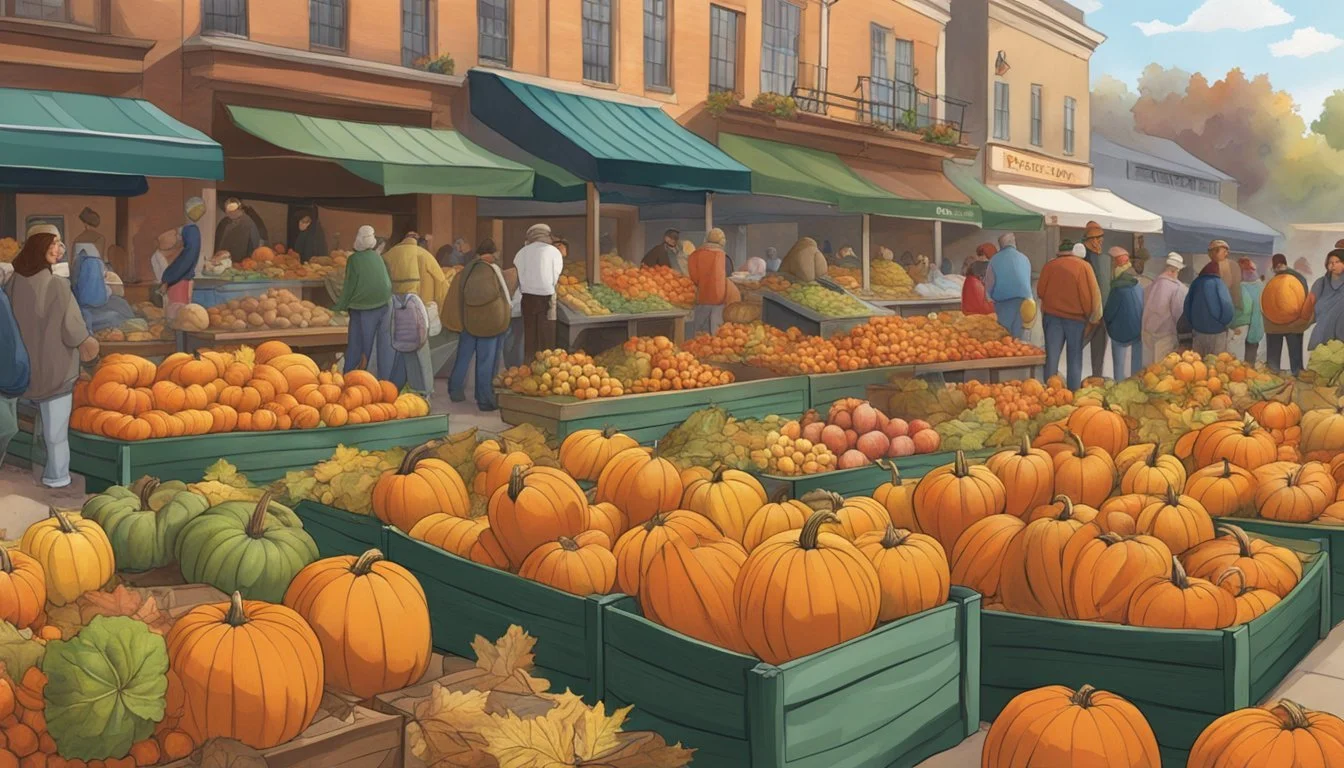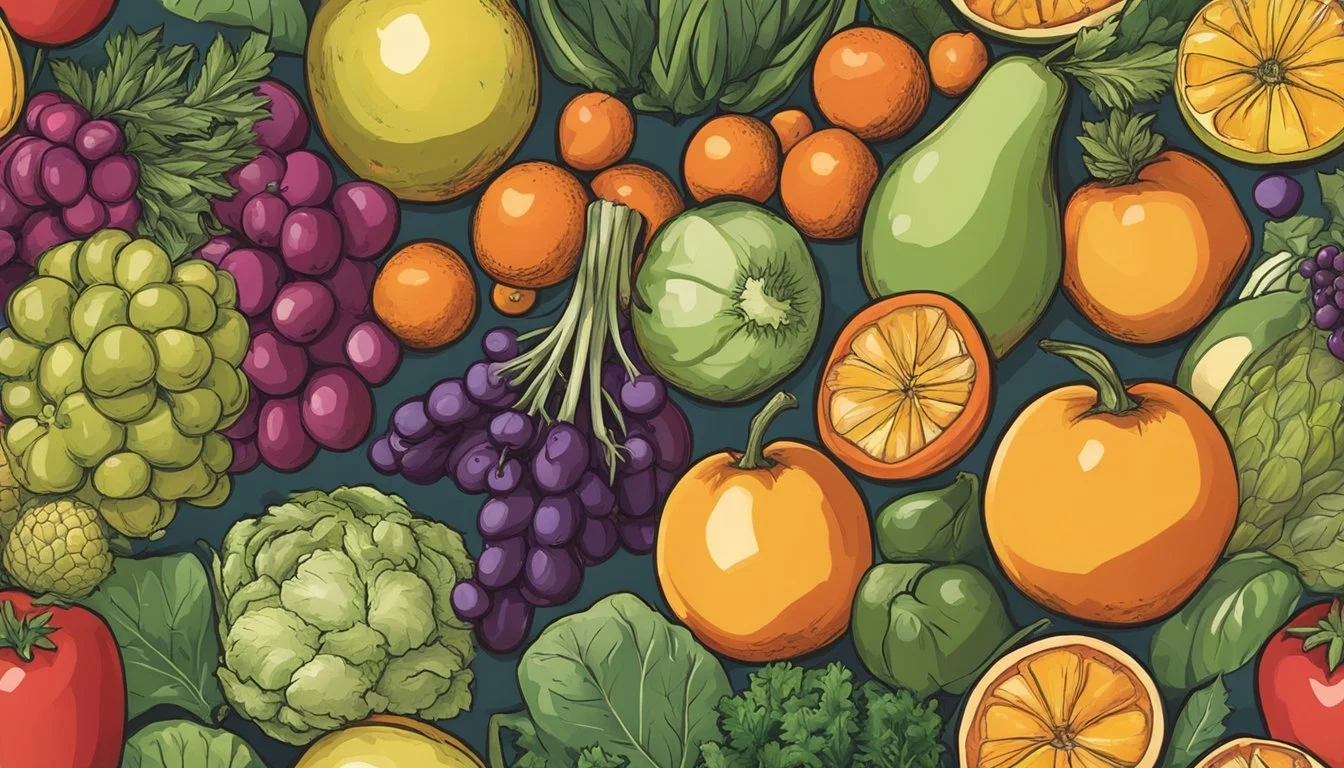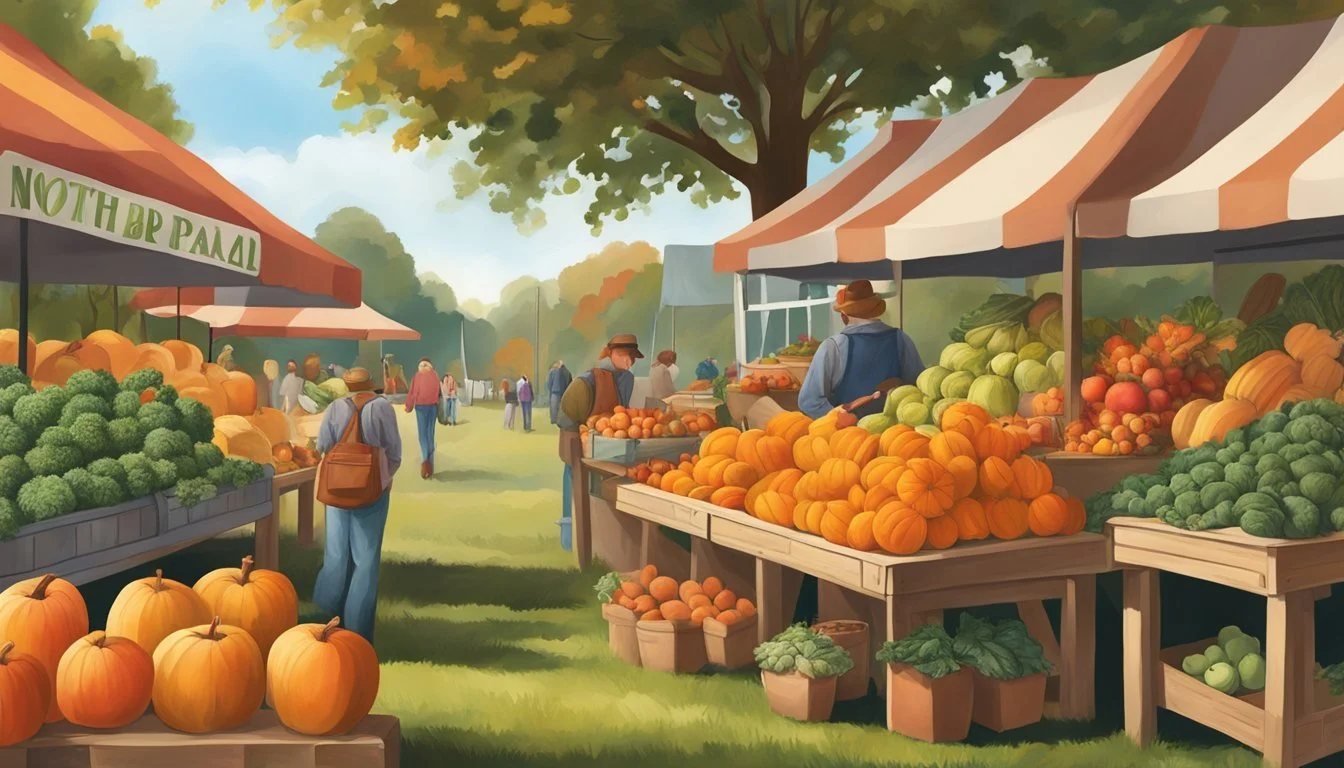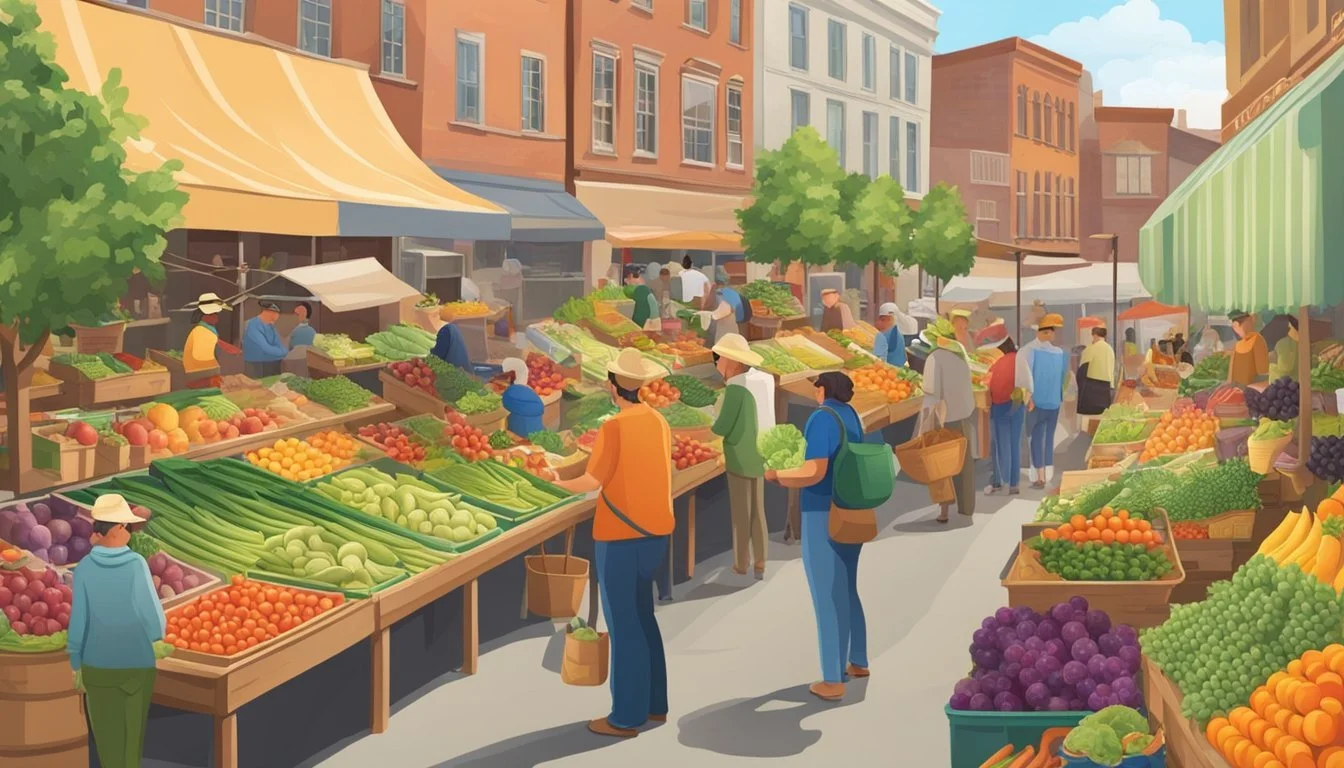North Carolina Seasonal Fruit & Vegetables in November
A Fresh Guide
This Article is Part of our North Carolina Seasonal Fruit & Veg Calendar
As the vibrant foliage of autumn blankets North Carolina, the state's harvest reflects the rich, earthy tones of November. A transition month in terms of produce, this time of year sees both the end of some crops and the peak of others. November in North Carolina offers a bountiful variety of fruits and vegetables.
Seasonal eating not only supports local agriculture but also ensures that consumers enjoy the freshest and tastiest produce. North Carolina's climate and soil yield a cornucopia of fruits and vegetables that are at their best in November. Root vegetables like sweet potatoes (What wine goes well with sweet potatoes?), which are a staple in the state's agriculture, carrots, and radishes are plentiful.
Among the leafy greens, collards are a Southern favorite still going strong in November, along with kale (What wine goes well with kale?) and mustard greens. Fruits, while not as abundant as in the summer, are represented by late-season apples (how long do apples last?) which are crisp and flavorful. This month encourages a celebration of the state’s rich produce, offering flavors and nutrition that are in sync with the cooler, cozier season.
Understanding Seasonality
Discovering the rhythm of seasonal produce is key to enjoying local, fresh fruits and vegetables at their peak of flavor and nutritional value.
Seasonal Produce Basics
Seasonality refers to the times of year when various fruits and vegetables are at their prime for harvest. In a seasonally-based approach, summer is often characterized by a bounty of berries and stone fruits, while fall brings root vegetables and hearty greens. Winter produce includes citrus and winter squash, with spring marking the arrival of tender leafy vegetables and early fruits. When produce is consumed in season, it not only tends to be more flavorful and nutritious but also supports the local economy and reduces environmental impact due to shorter transport distances.
North Carolina's Climate Impact
North Carolina's diverse climate ranges from the coastal plains to the mountainous regions, affecting the seasonal availability of produce.
Fall: Apples, Brussels sprouts, and sweet potatoes thrive in the crisp, cool air of autumn.
Winter: While many areas experience frost, some winter-hardy vegetables like kale and collards continue to grow.
Local markets often spotlight what's currently in season, offering consumers the freshest options.
By understanding how the local climate impacts what's available at markets during different seasons, consumers can make informed choices about the produce they buy and consume.
Fruits Available in November
In November, shoppers in North Carolina can enjoy a variety of fresh produce, including crisp apples and juicy pears. These fruits are at their peak, offering the freshest taste and highest quality during this month.
Apples
North Carolina produces a wide array of apple varieties that are ready for harvest in November. From the tart and tangy 'Granny Smith' to the sweet and aromatic 'Fuji,' the orchards in this state offer a selection to cater to every palate. Marking the end of the apple season, consumers can still find these favorites at local markets and farms.
Pears
November is also an ideal time for pear harvesting, with several varieties available that range in flavor and texture. 'Bartlett' pears, recognized for their classic shape and buttery flesh, are among the popular choices, while 'Bosc' and 'Anjou' pears are known for their firm texture that holds up well in cooking. These pears are a perfect addition to both sweet and savory dishes or can be enjoyed fresh.
Vegetables Available in November
In North Carolina, November ushers in a time of bountiful harvests, particularly with a variety of robust vegetables that withstand cooler temperatures. Among these, sweet potatoes, turnips, and winter squash stand out for their flavor and versatility in autumnal recipes.
Sweet Potatoes
Sweet potatoes are a staple in November for their rich taste and nutritional value. They are not only versatile, serving as a key ingredient in both sweet and savory dishes, but they also provide an abundance of vitamins A and C.
Harvest Period: Can be harvested throughout November
Preparation Ideas: Great for baking, roasting, or as a base for soups and pies.
Turnips
Turnips thrive in the cooler weather and are harvested in November. They come into their peak this month, offering a slightly sweet and peppery flavor to a variety of dishes.
Harvest Period: Readily available in November
Preparation Ideas: Can be roasted, mashed, or incorporated into stews.
Winter Squash
Winter squash is a term that encompasses a variety of squash types, such as butternut, acorn, and spaghetti squash. These vegetables are distinguished by their hard shells and sweet, nutty flesh, and they are an essential part of November's seasonal produce.
Harvest Period: Peaks during November
Preparation Ideas: Ideal for roasting, pureeing for soups, or stuffing as a hearty entree.
Herbs and Other Produce
In November, North Carolinians enjoy a variety of fresh herbs and tender greens. These plants not only add flavor but are readily available during the month.
Greens
Greens thrive in the cooler temperatures of North Carolina’s fall. During this time, residents can find a selection of leafy vegetables, which are praised for their nutritional value and earthy flavors. Notable greens include:
Kale: Robust and slightly bitter, kale is versatile in both raw and cooked applications.
Collards: Traditionally slow-cooked, collards offer a hearty flavor and are a staple in Southern cuisine.
Mustard Greens: These have a peppery bite, ideal for adding a kick to salads and stir-fries.
Herbs
Herbs harvested in November deliver robust flavors and are perfect for seasoning a variety of dishes:
Basil: Even though it peaks in summer, basil maintains its sweet and aromatic presence in the cooler months.
Cilantro: It lends a refreshing and citrusy note, often associated with Latin American and Asian dishes.
Parsley: This herb, with its clean and peppery flavor, acts as both a garnish and flavor enhancer in many recipes.
Availability of these herbs during November allows for the creation of flavorful, seasonal dishes that showcase the best of what North Carolina’s agriculture has to offer.
Locating Fresh Local Produce
In North Carolina during November, one can find an abundance of fresh produce by visiting local farmers markets and engaging with community gardens. These venues are prime for sourcing seasonal vegetables and fruits straight from the growers.
Farmers Markets
Farmers markets in North Carolina are bustling hubs where local farmers converge to sell their freshly harvested produce. Shoppers will likely find:
Broccoli: Available fresh as it's a cool-season crop harvested in November.
Brussels sprouts: These can also be typically found during this month.
Sweet potatoes: Often a staple at these markets, given their fall harvest.
Apples: Although the season is concluding, late varieties may still be present.
Leafy greens: Such as kale and collards, which thrive in cooler temperatures.
Attending a local farmers market not only supports regional agriculture but also provides access to the freshest possible ingredients.
Community Gardens
Community gardens serve a pivotal role in urban and suburban areas of North Carolina, offering plots for residents to grow their own produce. During November, community garden participants might be harvesting:
Carrots
Turnips
Lettuces
Community gardens not only provide access to fresh produce but also foster a sense of local camaraderie and shared agricultural knowledge.
Seasonal Recipes and Preservation
In November, North Carolina's markets are abundant with seasonal produce perfect for both home cooking and preservation. This section provides specific tips for creating flavorful dishes and preserving the freshness of fall's bounty.
Home Cooking Inspiration
November in North Carolina brings a variety of vegetables and fruits that can inspire warmth in any kitchen. Beet and cabbage based recipes, for example hearty beetroot stews or savory stuffed cabbages, are particularly fitting for the cooling weather. Broccoli can be transformed into a comforting cream of broccoli soup, while brussels sprouts can be roasted with a touch of olive oil and sea salt (how long does sea salt last?) for a simple, yet delicious side dish. Cantaloupes (how long does cantaloupe last?), although at the end of their season, can add a sweet note to a breakfast or be used in desserts such as sorbets.
Roasted Brussels Sprouts:
Clean and halve brussels sprouts.
Toss with olive oil, salt, and pepper.
Roast at 400°F until crisp (about 20-25 minutes).
Beetroot Stew:
Peel and chop beets (how long do beets last?) into cubes.
Sauté onions and garlic, add beets, and cook until tender.
Add broth and seasonings, simmering until flavors meld.
Canning and Storage Tips
Canning is a time-honored method of extending the life of seasonal produce, including both fruits and vegetables. Cabbage can be shredded and turned into sauerkraut, a classic preservation method that also offers probiotic benefits. Carrots and cauliflower can be pickled, while butter beans typically freeze well for long-term storage. When canning, it's important to follow proper safety guidelines, ensuring that all materials are sterilized and that correct procedures are followed to prevent spoilage.
For those not ready to dive into canning, many vegetables like cabbage and carrots keep well in a cool, dry place or refrigerator, and cantaloupes can be cubed and frozen to extend their usability.
Sauerkraut (Canning):
Shred cabbage and mix with salt.
Pack tightly into sterilized jars, ensuring liquid covers the cabbage.
Seal and process according to safe canning practices.
Slice or julienne carrots.
Bring vinegar, water, sugar, and spices to a boil.
Pour over carrots in sterilized jars and seal.
Following these tips, home cooks can confidently enjoy and preserve North Carolina’s November produce to savor well past the fall season.
Increasing Accessibility to Seasonal Foods
Access to seasonal fruits and vegetables in North Carolina during November can be enhanced through community-driven efforts and educational outreach. These initiatives focus on overcoming barriers to fresh produce such as distribution challenges and lack of awareness about the benefits and availability of seasonal options.
Community Initiatives
Farmers' Markets: Local farmers' markets play a crucial role in providing access to seasonal produce. For instance, Brussels sprouts, broccoli, and various types of cabbage are fresh in November and available directly from growers. Community support for these markets ensures that residents have regular access to fresh, seasonal foods, fostering both economic and nutritional benefits.
Affordable Pricing Models: North Carolina supports initiatives that enable affordable purchasing options for seasonal produce. Discount programs like "Double Bucks" increase the purchasing power of food assistance programs when used to buy fruits and vegetables at participating markets, improving accessibility for low-income households.
Educational Programs
Seasonal Eating Workshops: Educational programs aim to inform the community about the importance of seasonal eating. These workshops, often run by local health departments or non-profits, provide resources on how to utilize November's seasonal bounty like sweet potatoes and apples in nutritious, cost-effective ways.
School-Based Curricula: Integration of seasonal food education into school curricula can encourage students to make healthier choices. Programs that combine gardening with science or health classes enable children to learn about and experience the process of growing and consuming seasonal foods like kale or collards, which thrive in November's cooler temperatures.
Conclusion
In November, North Carolina's agricultural offerings are diverse and plentiful. The state's farmers' markets and local grocery stores showcase an array of seasonal produce that is both fresh and nutrient-rich. Consumers in North Carolina can take advantage of the following fruits and vegetables during the month:
Vegetables:
Broccoli
Brussels sprouts
Cauliflower
Sweet potatoes
Fruits:
Apples
This variety ensures that residents and visitors have access to fresh ingredients for their Thanksgiving feasts and other culinary endeavors.
Nutritionally, vegetables like broccoli and Brussels sprouts are high in fiber and vitamin C, whereas sweet potatoes are a great source of vitamin A and beta-carotene. Apples, on the other hand, are not only versatile but also provide dietary fiber and vitamin C. Their consumption supports local farmers and promotes sustainability within the community.
The commitment to eating seasonally in November supports North Carolina's agricultural economy. It fosters a closer connection between consumers and the food they eat. The practice of consuming locally-sourced and in-season produce is a step towards a healthier lifestyle and a more sustainable environment.








